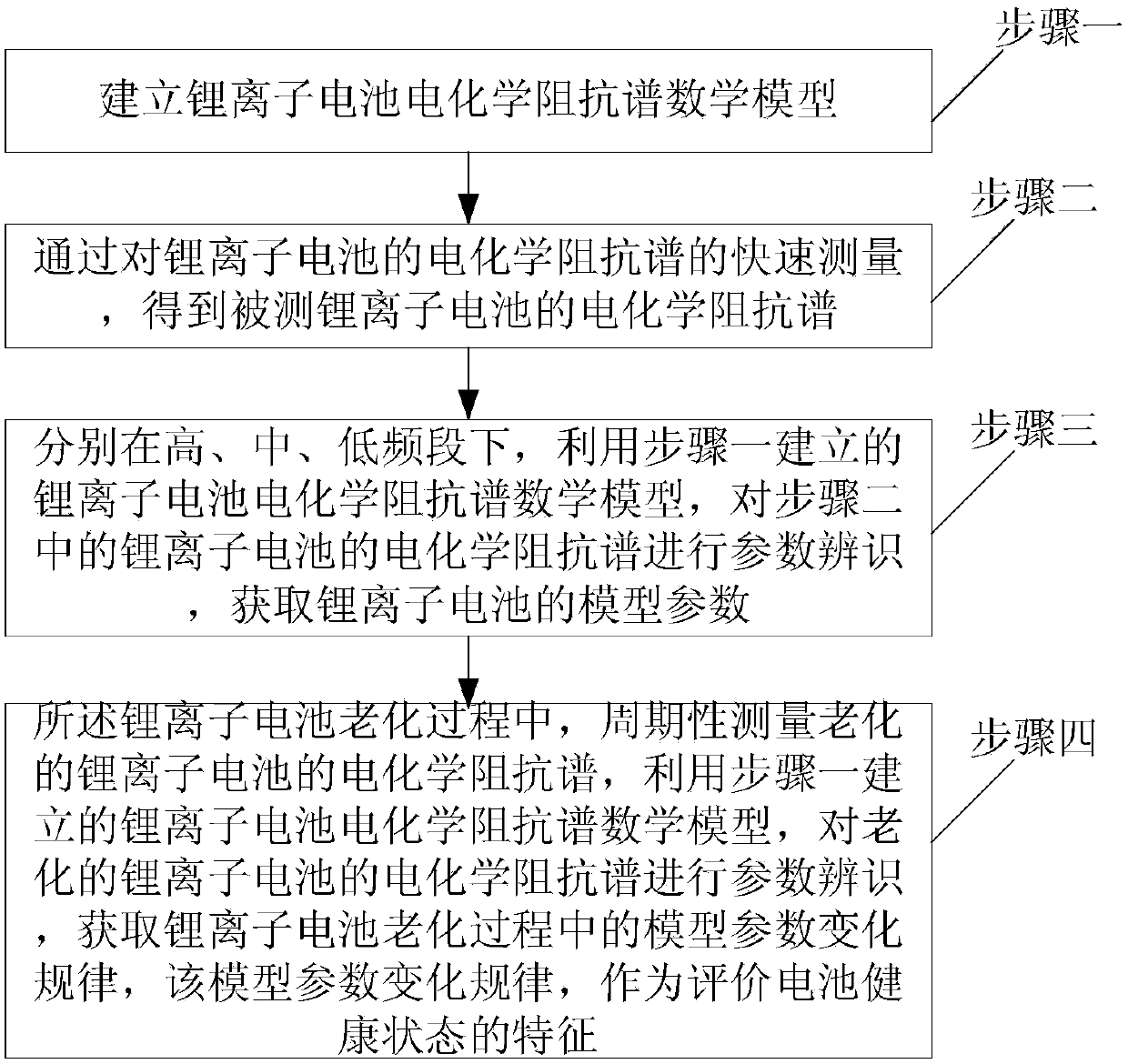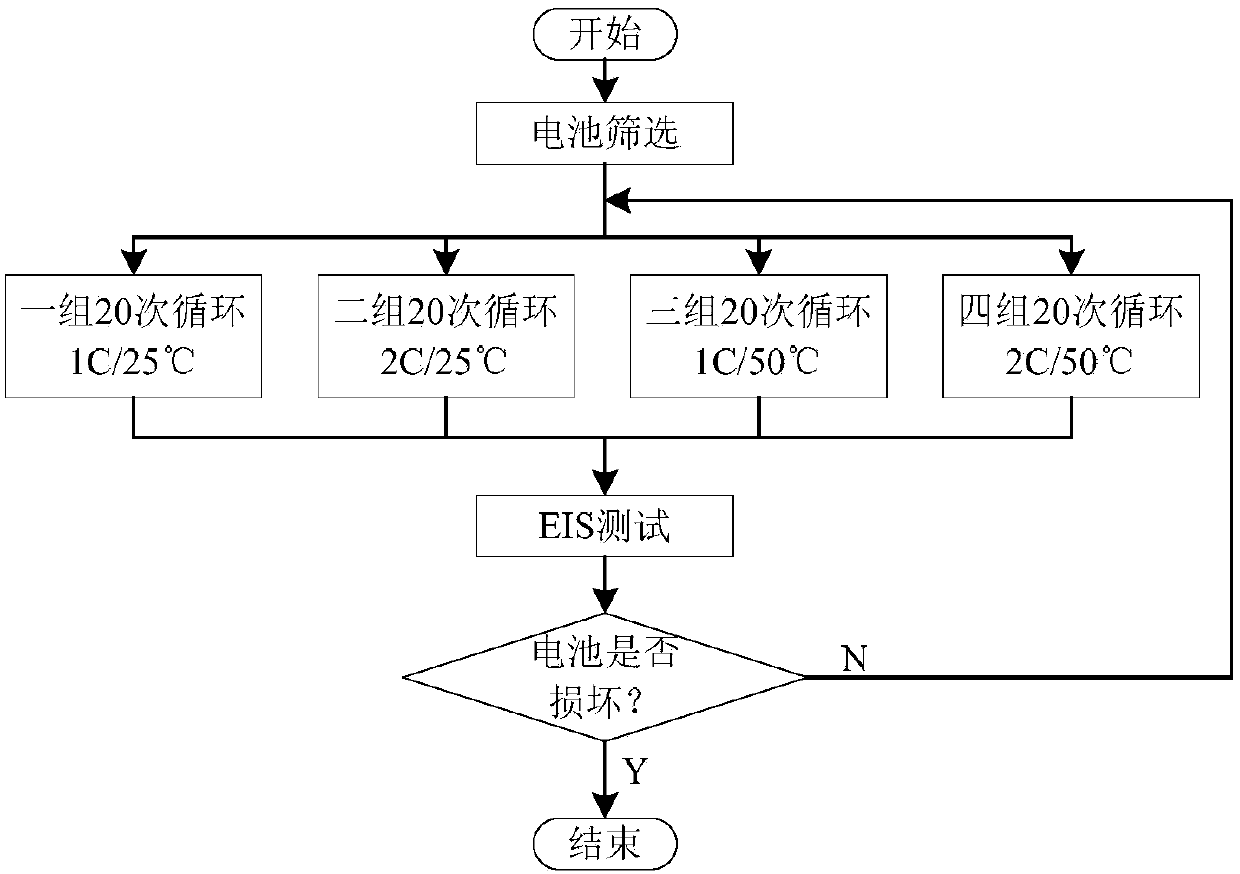Lithium ion battery internal health feature extraction method based on impedance spectrum
A lithium-ion battery and feature extraction technology, applied in the field of new energy research, can solve the problems of long EIS measurement time, inability to achieve online measurement, etc., and achieve the effect of short measurement time
- Summary
- Abstract
- Description
- Claims
- Application Information
AI Technical Summary
Problems solved by technology
Method used
Image
Examples
specific Embodiment approach 1
[0019] Specific implementation mode one: refer to figure 1 and image 3 Specifically explain this embodiment, a method for extracting internal health features of lithium-ion batteries based on impedance spectroscopy described in this embodiment, the method includes the following steps:
[0020] Step 1, establishing a lithium-ion battery electrochemical impedance spectroscopy mathematical model;
[0021] Step 2, obtain the electrochemical impedance spectrum of the lithium ion battery by fast measurement of the electrochemical impedance spectrum of the lithium ion battery;
[0022] Step 3. Under the high, medium and low frequency bands, use the mathematical model of the electrochemical impedance spectrum of the lithium-ion battery established in the first step to identify the parameters of the electrochemical impedance spectrum of the lithium-ion battery in the second step, and obtain the lithium-ion battery’s electrochemical impedance spectrum. model parameters;
[0023] Ste...
specific Embodiment approach 2
[0028] Specific embodiment two: this embodiment is a further description of a lithium-ion battery internal health feature extraction method based on impedance spectroscopy described in specific embodiment one. In this embodiment, in step one, the electrochemical impedance of lithium-ion batteries Spectral mathematical models include single particle impedance model without considering SEI film, single particle impedance model considering SEI film, condensate impedance model and porous electrode impedance model,
[0029] Single particle impedance model without considering SEI film for:
[0030]
[0031] In the formula, R ct is the load transfer resistance, R ct =RT / (i 0 F), R is the gas constant, T is the temperature, i 0 is the positive exchange current density, F is the Faraday constant, κ is 1, j is an imaginary number, ω is the frequency, is the partial conductance of potential to concentration, C dl is the electric double layer capacitance; transfer function ...
specific Embodiment approach 3
[0041] Specific implementation mode three: refer to figure 2 Describe this embodiment in detail. This embodiment is a further description of the method for extracting internal health features of lithium-ion batteries based on impedance spectroscopy described in the first embodiment. In this embodiment, in step 2, the lithium-ion battery The specific process of obtaining the electrochemical impedance spectrum of the lithium-ion battery is as follows:
[0042] Input a transient voltage signal to the lithium-ion battery, measure the current transient response curve of the lithium-ion battery, obtain the analytical function according to the measured transient response curve, and perform Laplace transformation on the analytical function, according to the transformed s-domain The input signal above and the output signal of the transient response curve are used to obtain the electrochemical impedance spectrum of the lithium-ion battery.
[0043] In this embodiment, during the aging...
PUM
 Login to View More
Login to View More Abstract
Description
Claims
Application Information
 Login to View More
Login to View More - R&D
- Intellectual Property
- Life Sciences
- Materials
- Tech Scout
- Unparalleled Data Quality
- Higher Quality Content
- 60% Fewer Hallucinations
Browse by: Latest US Patents, China's latest patents, Technical Efficacy Thesaurus, Application Domain, Technology Topic, Popular Technical Reports.
© 2025 PatSnap. All rights reserved.Legal|Privacy policy|Modern Slavery Act Transparency Statement|Sitemap|About US| Contact US: help@patsnap.com



